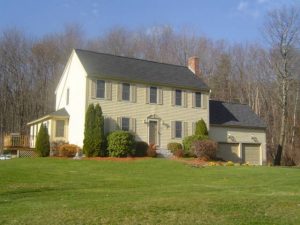Take your Time and Do your Homework when Selecting a Paint Scheme for Your Historical Home
By Mark J. Donovan
|
|
Choosing the right paint colors for an historical house can be a real challenge. Not only do you want to get it right, but often the town or local historical society requires it to. This can often mean selecting a few paint color schemes and then having to present them to a historical group to get approval to paint your home. Often historical houses used very similar paint colors and paint schemes. For example, in New Hampshire many old homes and buildings were painted white with either green or black shutters and trim work.
If a paint scheme of white and black/green sounds a little boring fear not there are other alternative paint schemes that you can consider. |
When developing a paint scheme for historical houses it’s important to remember a few key things about paints. Summarized below are some tips on selecting paint schemes for historical houses.
First, light paint colors make a home look larger than it is and dark colors make a home feel smaller. By using light paint colors you can also make a home feel closer to a road than conversely using a dark color.
Fourth, with any house painting project it is important that all moisture and mildew problems are first addressed prior to painting. Also, make sure to repair any damaged house siding and trim work prior to painting.
Fifth, talk to people. Paint stores have made it much easier to figure out the right paint schemes for a home. Talk with them about your historical home and what colors might work best. Also the local historical society can help. They are more than willing to provide information on what the typical color schemes were on old homes.
| As a matter of fact, and as I’ve already mentioned, they often will have a say in approving your historical home’s color scheme. So it’s wise to visit them regardless if you need any help or not in picking out your preferred color scheme for your historical home. There are also historical home paint consultants that you can also pursue who can give you advice on not only color schemes but types of paint.
Sixth, use technology. A lot of paint companies have sophisticated software programs that you can download off the internet to evaluate color schemes for your particular historical home style. These types of programs allow you to quickly test out different color schemes. |
 |
Seventh, as an alternative to painting your historical home you can stain it. The advantage of staining a historical home is that it penetrates into the wood and you don’t have to worry about peeling and cracking. The disadvantages of using stain, however, are that it will fade over time and it does not hide blemishes very well.
Finally, take your time. Owning an historical home is like owning a national treasure, so spend the extra time finding out what color schemes are best for your home to preserve and protect its heritage.
See the Installing Interior Window Ebook from HomeAdditionPlus.com. The Installing Interior Window Trim Ebook provides easy to understand, step-by-step instructions, on how to install interior window trim around a window. Pictures are included for every key step in the process.
Related Information
- DIY Exterior Painting of Old House
- Exterior House Painting on a New Home Tips
- Top 10 House Painting Tips
Additional House Painting and Staining Resources from Amazon.com
 |
 |
Painting and Staining Price Quotes For FREE, No Obligation!
Fill out our 3-5 minute quick and easy form, and receive a free price quote on painting & staining from one of our pre-screened and licensed painting & staining contractors. This process is free and there is no obligation to continue once you receive your painting price estimate.

